The Woodley Family
Johann Zoffany, RA (Frankfurt am Main 1733 - Kew 1810)
Category
Art / Oil paintings
Date
circa 1766
Materials
Oil on canvas
Measurements
1118 x 1651 mm (44 x 65 in)
Place of origin
London
Order this imageCollection
Kingston Lacy Estate, Dorset
NT 1257159
Caption
This is a group family portrait, or conversation-piece in a landscape. It was painted around 1766 when William Woodley MP (1728-1793), the father of the group, became the Governor of the Leeward Islands for the first time (a post that he was to hold until 1771 and again from 1792 until his death). William was also Lt-Governor of Antigua (1768–88 and 1792–3). Both the motif of the greyhound (‘windhund’ in the artist's native German) coursing a hare and the relief of the Sacrifice of Iphigenia on the replica of the Medici Vase seem to be puns alluding to the prevailing trade wind in the West Indies. Both William Woodley and his wife (also his cousin) Frances Payne, Mrs Woodley (1737/8-1813) had colonial roots in St Kitt’s. She is holding their baby son, John Woodley (1766-1795), later Attorney-General of St Kitt's in 1826, to whom their elder daughter Frances Woodley, later Mrs Henry Bankes the younger (1760-1823), is offering a rose. The young child pointing to the greyhound is Harriet, or Hariot Woodley, who later married Thomas Pickard of Bloxworth (1765-1844) in 1788, and became an amateur artist. The young William Woodley (1762-1810), seen here chasing an insect, became President of St Kitts in 1807 and Lt-Governor of Berbice in 1808.
Summary
Oil painting on canvas, The Woodley Family by Johann Zoffany RA (Frankfurt am Main 1733 - Kew 1810), circa 1766. The landscape view contains portraits of William Woodley (1728-1793); Frances Payne, Mrs Woodley (1737/8-1813); Frances Woodley, Mrs Henry Bankes the younger (1760-1823); William Woodley (1762-1810); Harriet Woodley (1765-1844) and John Woodley (1766-1795). Left to right: a greyhound, racing forward to the left, its forelegs raised in the air; William Woodley, full length, turned three-quarters to left, wearing a reddish coat, dark breeches, white stockings and tricorn hat; looking down both hands raised and widespread; William Woodley (1762-1810) as a young boy, full-length, turned to left, moving forward and looking up, his tricorn hat held in his right hand; Frances Woodley, Mrs Henry Bankes the Younger (1760-1823) as a young girl, full-length, turned three-quarters to right, holding her dress with her right hand and holding up a rose with her left, at her feet and sitting on the ground turned to left, is Harriet Woodley, Mrs Thomas Pickard (1765-1844) as a young child, full length, her right hand raised pointing to the dog; John Woodley (1766-1795), as a baby, full length held in the arms of his mother Frances Payne, Mrs Woodley (1737/8-1813)full length, dressed in a blue silk gown with white lace ruffles to her sleeves and a small white lace cap. Behind John Woodley is a plinth, with a reduced version of the Medici Vase (Uffizi); expansive landscape background to left and woodland to right.
Full description
It is tempting to see, in the somewhat unusual use of the motif of a greyhound coursing a hare to provide a focus of interest for this conversation-piece, a slightly laborious German pun. For the German for greyhound is Windhund (literally 'wind-dog'); and it would appear, both from the number of children shown and their ages, and on stylistic grounds (see The Atholl Family, 1767) that this picture was painted around 1766, when William Woodley, MP (1728 -93) was appointed Governor of the Leeward Islands, a post that he was to hold until 1771 (and again from 1792 until his death) . The Leeward Islands and the Windward Islands are two groups of islands forming the Lesser Antilles in the West Indies, known from their being respectively less or more exposed to the prevailing N.E. trade-wind. So, just as the wind-hound races away, William Woodley is about to go, with his family, to take up his post as Governor of the end of the Lesser Antilles that the wind blew away from. Perhaps this is all somewhat fanciful, but the motif is an unusual one, not to my knowledge otherwise employed by Zoffany as the pretext for a conversation-piece. Curiously, however, it can only have been a little later, around 1768/69, that he painted, and it was in 1769 that he exhibited at the Society of Arts, the first of at least two versions of A Porter with a Hare, in which the label on the dead hare, showing where the illiterate porter was to deliver it, is addressed to Zoffany himself . In taking up the post of Governor of the Leeward Islands, both William Woodley and his wife were returning to their colonial roots. For he was the eldest son and heir of William Woodley of St. Christopher, alias St Kitt's, and Ann Payne; whilst his wife Frances (1737/8 -1813), whom he had married in 1758 (and whom Reynolds painted around that time, in a head-and-shoulders portrait also at Kingston Lacy), was his cousin, the daughter of Abraham Payne, Jr., of St Kitt's . He was a Whig MP for Great Bedwyn in Lord Bruce/the Earl of Aylesbury's interest from 1761 to 1766 (and again for Marlborough, 1780 -84), and he owed his governorship to the Whig Prime Minister, Lord Rockingham . For some reason - presumably because he wished to set up as gentleman in England, and perhaps because it no longer lived up to its name - he sold his paternal plantation on St Kitt's, called 'Profit', in 1767; but he evidently held on to other estates there, since he later gave them as a reason for wanting to recover the Governorship. Woodley and his wife had two sons and three daughters, all but one of whom are shown here, thus enabling us to date the picture fairly precisely. The eldest boy, another William (†1810) shown chasing some insect with his hat, followed his father's career as a colonial administrator in Antigua, becoming President of St. Kitt's in 1807, and Lieutenant-Governor of Berbice in 1808. His younger brother, John (b.1766), the recently-born child held by his mother, became Attorney-General of St. Kitt's in 1826. The eldest girl, Frances (1760 -1823), shown handing him a rose, is the raison d'être for the existence of this picture at Kingston Lacy. For she became a celebrated beauty, and in 1784 married Henry Bankes the Younger, MP (1757 -1834). They were the parents of the second great collector of the family, William Bankes on whom she doted. She is the subject of a fine whole-length by Romney at Kingston Lacy. The child seated on the ground is Hariot, or Harriett, who married Thomas Pickard of Bloxworth in 1788; something of an amateur artist, she not only herself made pastel copies of works by Hoare, Reynolds, and Greuze, which are now at Kingston Lacy, but seems to have taught her sister-in-law, Anne Bankes, to do the same. The child as yet unborn, Maria (1772 -1808), was to be more celebrated than any of those shown in the Zoffany. A poet and author, in 1790 she married Lt Walter Riddell, who carried her to his ancestral home in Scotland, Friar's Carse, before taking another that he renamed Woodley Park . There she encountered Robert Burns, who subsequently addressed both flattering and satirical poems to her. A half-length portrait of her by Lawrence is also at Kingston Lacy. William Woodley III had a son of the same name, and Mrs. Riddell had a daughter, so that it is a slight puzzle that not only the Zoffany and the Reynolds portrait of their mother, but also Mrs. Riddell's own portrait, should all have come to Kingston Lacy - although apparently, in the case of the son, Captain William Woodley, RN, there was an estrangement from his aunts, because he felt that they had been over-favoured by his grandfather's will . But it may also be that the portraits were deliberately acquired by Frances Woodley's husband, Henry II Bankes, who is on record as appreciating English portraiture. Notes: (i) Vere Langford Oliver, The History of the Island of Antigua, vol.i, 1894, pp.cxxi & cxl & vol.iii, 1899, pp. 318 & 319. (ii) Manners & Williamson, 1920, pp.19 -20 & pl. opp.; exh. cat. Johann Zoffany, National Portrait Gallery, London, 1976, nos. 45 & 46. (iii) For their two families, see Oliver, op.cit., vol.iii, 1899, pp.256 -64. (iv) Sir Lewis Namier & John Brooke, The House of Commons 1754 -1790, 1964, vol.iii, pp.657 -58. (v) Angus Macnaghten, Family Roundabout, Edinburgh, 1955, pp.19 -20; do., Family Quest, Cambridge, 1958, pp.56 -61. (vi) Information kindly supplied by D. William S. Woodley, letter of 5 November 1982. (vii) When, at his mother's request, he sat to Batoni in Rome in 1779, he wrote to her of the result that it was: "a melancholy cold picture, whose only merit is being simple and having nothing offensive ... to speak without prejudice, I do not think his portraits equal to those of Reynolds." (Bankes Papers, Dorset Record Office). (adapted from author's version/pre-publication, Alastair Laing, In Trust for the Nation, exh. cat., 1995)
Provenance
first recorded at Kingston Lacy in a partial and undated inventory of between 1815 and 1834, presumably by family descent to Frances Woodley, Mrs Henry II Bankes (1760 -1823); there, by descent, until bequeathed to the National Trust, with the whole estates and contents of Kingston Lacy and Corfe Castle, by Ralph Bankes, 1981
Credit line
Kingston Lacy, The Bankes Collection (National Trust)
Makers and roles
Johann Zoffany, RA (Frankfurt am Main 1733 - Kew 1810), artist
Exhibition history
In Trust for the Nation, National Gallery, London, 1995 - 1996, no.22

